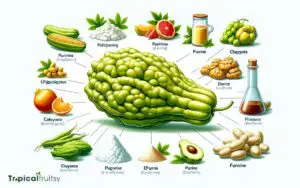Is Chayote Good for Uric Acid
Chayote is considered a suitable food for those with concerns about uric acid. As a low-purine food, it is unlikely to raise uric acid levels and may be a smart choice for individuals with gout or hyperuricemia.
The nutritional benefits of chayote, including its vitamin, mineral, and fiber content, support overall health and can be part of a diet aimed at regulating uric acid levels.
It’s important to note that while chayote can be incorporated into a uric acid-conscious diet, total dietary habits and lifestyle choices play a substantial role in managing health conditions related to uric acid.
Chayote is a low-calorie fruit often used in the diet of those who need to control their uric acid levels. High uric acid can lead to gout, a form of arthritis characterized by severe pain and swelling in the joints.
Here’s why chayote is good for uric acid management:
Eating chayote as part of a balanced diet can help maintain normal uric acid levels.
Incorporate chayote into your diet to help manage uric acid levels without sacrificing nutritional value.

Key Takeaway
Chayote Nutritional Benefits for Uric Acid Management
| Nutrient | Amount per 100g | Benefit for Uric Acid Management |
|---|---|---|
| Calories | 19 kcal | Low energy intake helps in weight management |
| Purines | Low | Reduces potential uric acid production |
| Dietary Fiber | 1.7 g | May decrease uric acid absorption |
| Vitamin C | 7.7 mg | Has antioxidant properties that may help reduce uric acid levels |
| Vitamin B6 | 0.123 mg | Involved in purine metabolism, which can help in managing uric acid levels |
| Potassium | 125 mg | May help reduce gout symptoms by assisting in uric acid excretion |
| Magnesium | 12 mg | Supports kidney function, aiding in the excretion of uric acid |
| Zinc | 0.74 mg | Supports immune function and overall health |
Understanding Uric Acid
In the context of human metabolism, uric acid is a waste product that is formed during the breakdown of purines, which are found in certain foods and the cells of the body. Normally, uric acid dissolves in the blood, passes through the kidneys, and is excreted in urine.
However, when the body produces excessive uric acid or the kidneys excrete too little, it can accumulate, leading to hyperuricemia. This condition is associated with gout, a type of arthritis characterized by painful joint inflammation.
Managing uric acid levels typically involves dietary adjustments and lifestyle changes.
With this understanding of uric acid’s role in health, we can now examine the nutritional attributes of chayote and its potential impact on uric acid management.
Chayote Nutritional Profile
Chayote, scientifically known as Sechium edule, is recognized for its low-calorie composition, which makes it a favorable option for individuals monitoring their energy intake. It is also a significant source of dietary fiber, contributing to satiety and digestive health.
Furthermore, chayote contains vitamin C, an antioxidant that plays a vital role in immune function and skin health.
Low-Calorie Content
While chayote is low in calories, providing just 19 calories per 100 grams, this attribute contributes to its potential benefits for managing uric acid levels.
A diet lower in calories can help maintain a healthy weight, which is crucial because excess body weight is a risk factor for gout, a condition associated with high uric acid levels.
Chayote’s nutritional profile is noteworthy for its balance of essential nutrients and minimal caloric impact:
- Fiber: About 1.7 grams per 100 grams, aiding in digestion and satiety.
- Vitamin C: A potent antioxidant, with about 7.7 mg per 100 grams.
- Magnesium: Contains about 12 mg per 100 grams, important for numerous bodily functions.
- Potassium: With approximately 125 mg per 100 grams, it helps regulate fluid balance and blood pressure.
Incorporating chayote into a diet geared toward managing uric acid can be advantageous due to its low-calorie content alongside these essential nutrients.
Rich in Fiber
The fiber content in chayote, at 1.7 grams per 100 grams, not only promotes fullness but also aids in reducing the body’s uric acid levels through improved digestive health.
Fiber is a crucial component of a healthy diet, known for its ability to facilitate regular bowel movements and enhance the excretion of waste products like uric acid.
Adequate fiber intake is associated with a lower risk of developing gout, a condition characterized by elevated uric acid levels that can lead to painful joint inflammation.
Vitamin C Presence
In addition to its beneficial fiber content, chayote is also a valuable source of vitamin C, which plays a significant role in the reduction and maintenance of uric acid levels in the body.
The presence of vitamin C in chayote contributes to several health benefits:
- Antioxidant Properties: Vitamin C is a powerful antioxidant that helps protect the body from damage by free radicals, which can contribute to the development of conditions like gout.
- Collagen Synthesis: It is essential for the synthesis of collagen, which aids in the repair and maintenance of cartilage, joints, and tendons.
- Immune Support: This nutrient supports the immune system, which can be compromised in individuals with high uric acid.
- Uric Acid Metabolism: Vitamin C has been shown to help lower serum uric acid levels, potentially reducing the risk of gout flare-ups.
Utilizing chayote in a diet can therefore be a strategic approach to managing uric acid levels through its nutritional profile.
Chayote and Uric Acid Connection
Chayote exhibits potential in reducing uric acid levels due to its low purine content and diuretic properties.
Purines are natural substances found in food, which, when metabolized, produce uric acid as a waste product. High levels of uric acid can lead to gout, a form of inflammatory arthritis.
Chayote, being low in purines, contributes minimally to uric acid production, making it a suitable dietary option for individuals managing their uric acid levels. Moreover, its diuretic effect could assist in promoting the excretion of uric acid through urine.
This vegetable also contains antioxidants and vitamins that may support overall health, potentially aiding the body’s natural processes in maintaining balanced uric acid levels.
Purine Content in Chayote
A chayote squash contains a notably low level of purines, making it a favorable choice for those seeking to manage their uric acid levels.
Purines are chemical compounds that, when metabolized, produce uric acid. High levels of uric acid can lead to gout and other health issues.
When considering the purine content in foods, chayote is an excellent option for those on a low-purine diet due to its composition:
- Very Low Purine Content: Chayote is categorized as a food with very low purine content.
- Uric Acid Production: Its consumption is unlikely to result in significant increases in uric acid production.
- Vegetable Selection: It is often recommended by nutritionists as a suitable vegetable for those managing hyperuricemia.
- Dietary Integration: Chayote can be easily integrated into a variety of dishes without concern for purine overload.
Understanding the role of chayote in a gout diet will further illuminate its benefits in managing uric acid levels.
Chayote in a Gout Diet
Incorporating chayote into a diet designed for gout sufferers can contribute to maintaining lower uric acid levels due to its minimal purine content.
A gout diet typically involves the restriction of purine-rich foods to prevent the buildup of uric acid, which can crystallize in joints and cause the characteristic pain and inflammation.
Chayote, a low-purine vegetable, is an excellent addition to such a diet. Its consumption provides essential nutrients without significantly increasing uric acid production.
Moreover, chayote is rich in vitamin C, which some studies suggest may help in reducing uric acid levels.
Cooking Methods and Nutrient Retention
While several cooking methods can be employed to prepare chayote, steaming or boiling is often recommended to preserve its nutrient profile, which is particularly beneficial for individuals monitoring their uric acid levels.
Nutrient retention is crucial for maximizing the health benefits of chayote, and the following cooking practices are optimal:
- Steaming: This gentle cooking method helps retain vitamins and minerals, reducing the risk of nutrient loss into cooking water.
- Boiling: When using minimal water, it can limit the leaching of water-soluble nutrients.
- Sautéing: Quick cooking at moderate temperatures can preserve antioxidants but should be done with minimal oil.
- Raw consumption: Eating chayote raw ensures no nutrient loss due to heat, offering the most natural benefits.
These methods not only maintain the vegetable’s nutritional integrity but also impact the overall management of uric acid levels positively.
Incorporating Chayote Into Your Diet
As individuals seek to manage their uric acid levels, integrating chayote into daily meals can be an effortless and versatile approach to enhancing their dietary regimen.
This gourd-like vegetable is not only low in purines, which are known to exacerbate uric acid production, but is also rich in vitamins and fiber.
Evidence suggests that consuming foods with high water content and anti-inflammatory properties, like chayote, may assist in reducing uric acid concentrations.
It can be consumed raw in salads, steamed as a side dish, or even incorporated into stews and soups.
When prepared properly, chayote retains its nutrients and can contribute to a balanced, uric acid-conscious diet.
Other Foods to Manage Uric Acid
Several other foods, alongside chayote, have been recognized for their ability to help manage uric acid levels, offering a variety of options for those looking to maintain a uric acid-conscious diet.
These include:
- Cherries: Studies suggest that cherries can reduce uric acid concentrations and inflammation, possibly due to their high levels of anthocyanins.
- Dairy Products: Low-fat milk and yogurt are associated with lower uric acid levels and reduced risk of gout flare-ups, as they contain orotic acid that may decrease uric acid reabsorption.
- Whole Grains: Whole grains like oats and brown rice provide fiber and nutrients that may aid in uric acid excretion.
- Water: Adequate hydration can assist in flushing uric acid from the body, thus potentially preventing gout attacks.
Conclusion
Chayote emerges as a beneficial addition to diets targeting uric acid control. Its low purine content supports its inclusion in gout management plans.
As a nutrient-rich vegetable with a favorable impact on uric acid levels, chayote can be strategically integrated into meals.
Employing proper cooking methods ensures maximum retention of its advantageous attributes. Alongside other low-purine foods, chayote contributes to a comprehensive dietary approach for managing hyperuricemia and gout.





